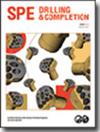Pressure Decline Analysis in Fractured Horizontal Wells: Comparison between Diagnostic Fracture Injection Test, Flowback, and Main Stage Falloff
IF 1.2
4区 工程技术
Q3 ENGINEERING, PETROLEUM
引用次数: 6
Abstract
The pressure decline data after the end of a hydraulic fracture stage are sometimes monitored for an extended period of time. However, to the best of our knowledge, these data are not analyzed and are often ignored or underappreciated because of a lack of suitable models for the closure of propped fractures. In this study, we present a new approach to model and analyze pressure decline data that are available in unconventional horizontal wells with multistage, transverse hydraulic fracturing. The methods presented in this study allow us to quantify closure stress and average pore pressure inside the stimulated reservoir volume (SRV) and to infer the uniformity of proppant distribution without additional data acquisition costs. For the first time, field data of diagnostic fracture injection test (DFIT), flowback, and pressure decline of main fracturing stages from the same well are compared and analyzed. We found that the early-time main fracturing stage pressure decline trend is controlled by fracture tip extension, followed by progressive hydraulic fracture closure on the proppant pack, whereas late-time pressure decline reflects linear flow. When DFIT data are not available, pressure decline analysis of a main hydraulic fracturing stage can be a substitution if it can be monitored for an extended period to allow fracture closure on proppants and asperities.压裂水平井压降分析:诊断性压裂注入测试、返排和主级降的比较
水力压裂阶段结束后的压力下降数据有时会被监测很长一段时间。然而,据我们所知,由于缺乏合适的支撑骨折闭合模型,这些数据没有得到分析,而且经常被忽视或低估。在这项研究中,我们提出了一种新的方法来建模和分析具有多级横向水力压裂的非常规水平井的压降数据。本研究中提出的方法使我们能够量化受激储层体积(SRV)内的闭合应力和平均孔隙压力,并推断支撑剂分布的均匀性,而无需额外的数据采集成本。首次对同一口井主要压裂阶段的诊断性裂缝注入试验(DFIT)、返排和压降的现场数据进行了比较和分析。我们发现,早期主压裂阶段的压力下降趋势受裂缝尖端延伸的控制,随后是支撑剂充填上的渐进水力裂缝闭合,而后期的压力下降反映了线性流动。当DFIT数据不可用时,如果可以对主要水力压裂阶段的压降分析进行长时间的监测,以允许支撑剂和微凸体上的裂缝闭合,则可以对其进行替代。
本文章由计算机程序翻译,如有差异,请以英文原文为准。
求助全文
约1分钟内获得全文
求助全文
来源期刊

SPE Drilling & Completion
工程技术-工程:石油
CiteScore
4.20
自引率
7.10%
发文量
29
审稿时长
6-12 weeks
期刊介绍:
Covers horizontal and directional drilling, drilling fluids, bit technology, sand control, perforating, cementing, well control, completions and drilling operations.
 求助内容:
求助内容: 应助结果提醒方式:
应助结果提醒方式:


